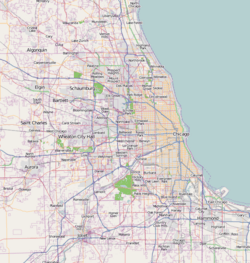Falconer Bungalow Historic District facts for kids
Quick facts for kids |
|
|
Falconer Bungalow Historic District
|
|
 |
|
| Location | Roughly bounded by W. Wellington Ave., N. Lamon Ave., N. Laramie Ave., and the alley N of W. Diversey Ave., Chicago, Illinois |
|---|---|
| Area | 59.2 acres (24.0 ha) |
| Architectural style | Chicago bungalow |
| MPS | Chicago Bungalows MPS |
| NRHP reference No. | 07000114 |
| Added to NRHP | March 7, 2007 |
The Falconer Bungalow Historic District is a special neighborhood in Chicago, Illinois. It's known for its many unique homes called Chicago bungalows. This district has 348 of these homes, built between 1915 and 1931.
In the early 1900s, it became easier for people to own their own homes in Chicago. Chicago bungalows became very popular because they were affordable and easy to build. Thousands of them were built all over the city. The Belmont Cragin area, where this district is, was a new part of the city that was still developing.
The district is named after Laughlin Falconer. He used to own and farm the land before selling it to builders in 1913. Many of the bungalows here were designed by architects Ernest Braucher and Johan F. Knudson. They often included open-air front porches on their houses. Because of this, the Falconer District has one of the largest collections of bungalows with open front porches in Chicago.
This historic district was added to the National Register of Historic Places on March 7, 2007. This means it's recognized as an important place in history.
How the District Grew
In the mid-1800s, a Scottish immigrant named Laughlin Falconer settled on this land. He used it for farming. By the early 1900s, the area started to change. It became a mix of factories, shops, and homes.
Home building in the Falconer District began in November 1915. Edward H. Olsen and Henry Van Vooren started building bungalows on West Oakdale Avenue.
A very important person in the district's growth was George C. Hield. He used to sell hay in Wisconsin. Between 1913 and 1919, Hield bought most of the land that the Falconer family had divided up.
According to the Chicago Tribune newspaper, Hield planned to build many different types of homes. These included single-family houses, bungalows, and two-flat buildings.
From 1915 to 1921, Hield, Olsen, and Van Vooren built almost all the homes in the district. After 1921, many other builders and architects joined in. They built 240 more homes between 1921 and 1925.
A Neighborhood for Working Families
The Falconer Historic District was built near industrial and manufacturing areas. This was common for bungalow neighborhoods in Chicago's northwest. Developers built homes close to major workplaces.
Many families in the Belmont Cragin community worked in factories or offices. This meant that older children and other family members could also find jobs nearby. Their earnings helped the household economy. This was especially helpful during the Great Depression in the early 1930s.
For example, one family had a father who tuned pianos at a music factory. His oldest son worked at a clothing factory. His 19-year-old son was a file assistant at an electric parts company. Everyone contributed to the family's income.




